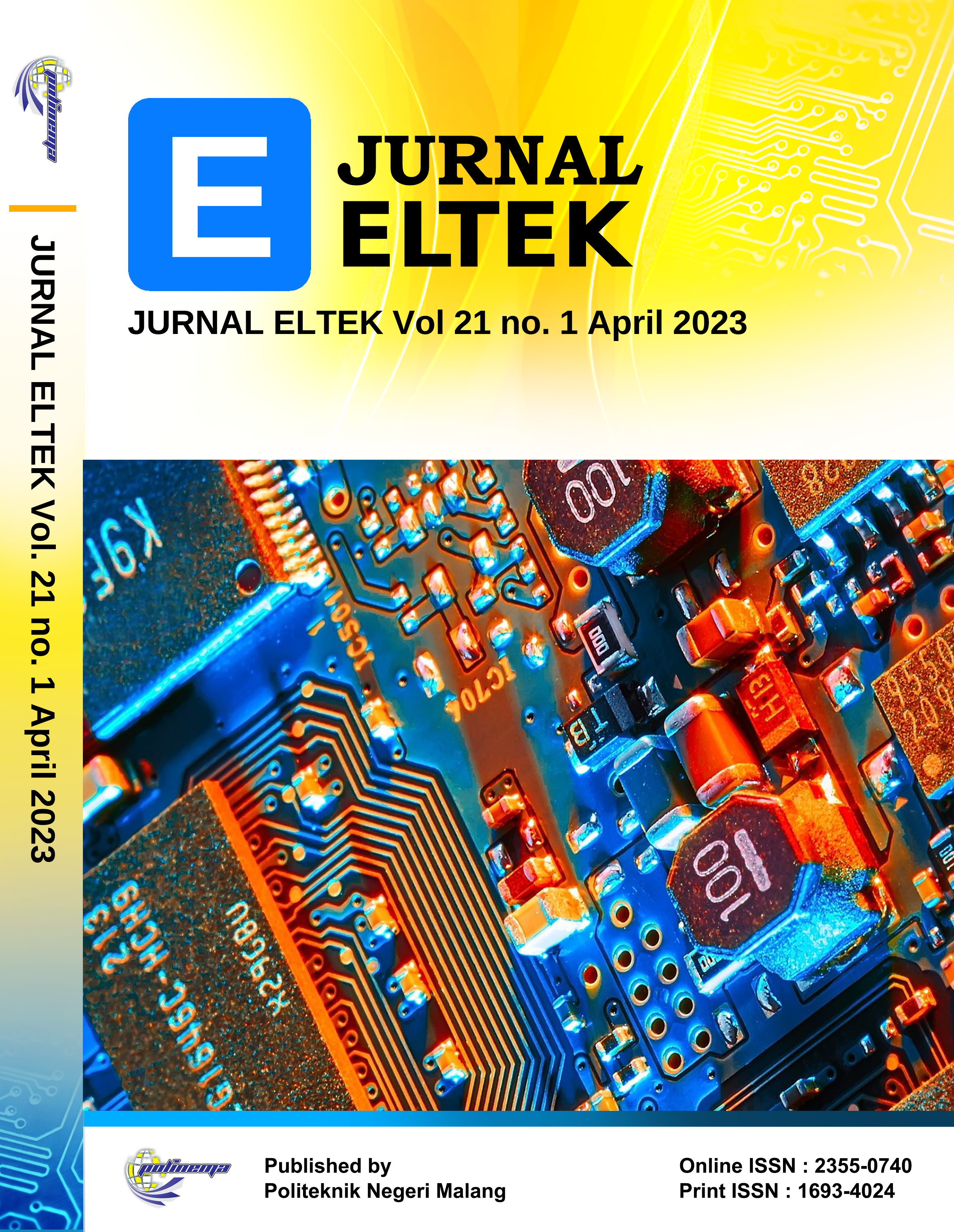Smart hand glove terapi pasien pasca stroke berbasis internet of things (IoT)
DOI:
https://doi.org/10.33795/eltek.v21i1.3012Keywords:
hand glove, IoT, TastechAbstract
Stroke Transient Ischemic Attack (TIA) adalah kondisi stroke ringan yang dapat disebabkan oleh berkurangnya suplai darah menuju otak diakibatkan pembuluh darah tersumbat. Kurangnya aliran darah ke otak dapat menyebabkan kelumpuhan, biasanya hanya pada satu sisi tubuh. Fisioterapi pada pasien pasca stroke ringan dilakukan dengan metode terapi gerakan antara lain yaitu elbow dan knee flexion. Fisioterapi adalah metode pengobatan yang umum digunakan oleh masyarakat, pengobatan ini mahal dan memerlukan mobilitas. Berdasarkan data riset kesehatan dasar, ditemukan bahwa status ekonomi merupakan salah satu penentu utama efektivitas fisioterapi. Oleh karena itu, dibuatlah alat smart hand glove terapi pasien pasca stroke yang digunakan pada bagian tangan dan dilengkapi sebuah aplikasi yang disebut sebagai "Therapy Stroke Technology (TASTECH) untuk monitoring. Alat ini bekerja dengan integrasi antara sensor MPU6050 dan MAX30102 yang terhubung dengan ESP32 serta dapat dimonitoring oleh dokter atau terapis. Dari hasil pengujian akurasi sensor MPU6050 mampu mendeteksi sudut dari 100-900 sebesar 98,64%. Kemudian untuk sensor MAX30102 setelah diuji akurasi dengan perbandingan pulse oximeter tipe Lk87 didapatkan nilai akurasi SPO2 99,37% dan rata-rata BPM 99,22%. Aplikasi TASTECH ini dilengkapi dengan berbagai menu menarik seperti pusat informasi dan konsultasi yang dibuat dengan user friendly, TASTECH juga dapat digunakan dimana dan kapan saja dikarenakan bentuk alat ini yang portable dan tentunya ergonomis.
ABSTRACT
Transient Ischemic Attack (TIA) stroke is a mild stroke condition that can be caused by reduced blood supply to the brain due to blocked blood vessels. Lack of blood flow to the brain can cause paralysis, usually on only one side of the body. Physiotherapy in post-stroke patients is carried out using movement therapy methods, including elbow and knee flexion. Physiotherapy is a treatment method that is commonly used by the community, this treatment is expensive and requires mobility. Based on Basic Health Research data, it was found that economic status is one of the main determinants of the effectiveness of physiotherapy. Therefore, a Smart Hand Glove tool was created for post-stroke patient therapy which was used on the hands and equipped with an application called "Therapy Stroke Technology (TASTECH) for monitoring. TASTECH works by integrating the MPU6050 and MAX30102 sensors that are connected to the ESP32 and can be monitored by a doctor or therapist. From the results of testing the accuracy of the MPU6050 sensor is able to detect angles from 100-900 by 98.64%. Then for the MAX30102 sensor after being tested for accuracy with a comparison of the Lk87 type pulse oximeter, the SPO2 accuracy value is 99.37% and the BPM average is 99.22%. The TASTECH application is equipped with various interesting menus such as an information center and consultation which is made user friendly, TASTECH can also be used anywhere and anytime due to the shape of this tool which is portable and of course ergonomic.
References
R. A. Laksono, N. D. Mukti, and D. Nurhamidah, “Dampak Makanan Cepat Saji Terhadap Kesehatan pada Mahasiswa Program Studi ‘X’ Perguruan Tinggi ‘Y,’” Jurnal Ilmiah Kesehatan Masyarakat : Media Komunikasi Komunitas Kesehatan Masyarakat, vol. 14, no. 1, pp. 35–39, Feb. 2022, doi: 10.52022/jikm.v14i1.282.
Kemenkes RI, “Stroke: Don’t be the One,” Jakarta , Nov. 2018.
W. Riyadina and E. Rahajeng, “Determinan Penyakit Stroke,” Kesmas: National Public Health Journal, vol. 7, no. 7, p. 324, Feb. 2013, doi: 10.21109/kesmas.v7i7.31.
D. Krisnawati and L. Anggiat, “Terapi Latihan Pada Kondisi Stroke: Kajian Literatur = Exercise Therapy In Stroke Condition: A Literature Review,” Jurnal Fisioterapi Terapan Indonesia, vol. 1, pp. 1–10, Aug. 2021.
M. A. Sulistiyowati, “Hubungan Lama Menderita Stroke Dengan Kepatuhan Menjalani Fisioterapi pada Pasien Stroke,” Jurnal Smart Keperawatan, vol. 7, no. 2, p. 104, Dec. 2020, doi: 10.34310/jskp.v7i2.353.
Siti Fadlilah, Fransiska Lanni, and Romadhani Tri Purnomo, “Analisis Faktor yang Berhubungan dengan Kepatuhan Fisioterapi Pasien Pasca Stroke di RS Bethesda Yogyakarta,” Jurnal Ilmu Kesehatan, vol. 10, no. 2, pp. 112–120, Dec. 2019.
SYAHRUL FITRA and S. T. , M. Eng. Dr.Eng. Herianto, “DESAIN DAN MANUFAKTUR ROBOT REHABILITASI LUTUT UNTUK PASIEN PASCA STROKE,” Thesis, Universitas Gadjah Mada, DIY, 2016.
T. PERKASA and H. H. RACHMAT, “Perancangan Alat Ukur Sudut Tekuk Lutut Wireless menggunakan Sensor Gyroscope berbasis ATMega 328 dan ATMega 2560,” ELKOMIKA: Jurnal Teknik Energi Elektrik, Teknik Telekomunikasi, & Teknik Elektronika, vol. 5, no. 1, p. 30, Mar. 2018, doi: 10.26760/elkomika.v5i1.30.
L. Y. Amali and I. M. L. Batan, “Perancangan Alat Rehabilitasi Pergelangan Tangan Pasien Pasca Stroke yang Digerakkan Motor Servo,” Jurnal Sains dan Seni ITS, vol. 10, no. 1, Sep. 2021, doi: 10.12962/j23373520.v10i1.59127.
Hayder J Hassaballah and Rashid A Fayad, 2020, Implementation of wireless sensor network for medical applications, IOP Conference Series: Materials Science and Engineering
Antonio Carlos Bento 2020, An Experimental Survey with NodeMCU12e+Shield with Tft Nextion and MAX30102 Sensor, IEE Proceedings, December 2020
Downloads
Published
How to Cite
Issue
Section
License
Copyright (c) 2023 Lis Diana Mustafa, Azam Muzakhim Imamuddien, Yoyok Heru Prasetyo Isnomo

This work is licensed under a Creative Commons Attribution-ShareAlike 4.0 International License.







